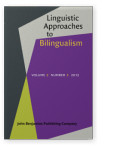Commentary
Why and how individual differences matter for linguistic theory and experimental research but not for UG
Article outline
- Why and how individual differences matter for linguistic theory
- Why and how individual differences matter for experimental research
- Notes
-
References
References (24)
Bayer, J.
(
1984)
COMP in Bavarian syntax.
The Linguistic Review, 31, 209–274.


Chomsky, N.
(
1995)
The minimalist program. Cambridge, MA: MIT Press.

Chomsky, N.
(
2000)
Minimalist inquiries. In
R. Martin,
D. Michaels, &
J. Uriagereka (Eds.),
Step by step: Essays on minimalist syntax in honor of howard Lasnik (pp. 89–155). Cambridge, MA: MIT Press.

Chomsky, N.
(
2001)
Derivation by phase. In
M. J. Kenstowicz (Ed.),
Ken Hale: A Life in Language (pp. 1–52). Cambridge, MA: MIT Press.

Crain, S.
(
1991)
Language acquisition in the absence of experience.
Behavioral and Brain Sciences, 141, 597–612.


de Villiers. J.G., & de Villiers. P.A
(
1973)
Development of the use of word order in comprehension.
Journal of Psycholinguistic Research, 2(4), 331–341.


Drozd, K.
(
2004)
Learnability and linguistic performance.
Journal of Child Language, 311, 431–457.


Genesee, F.
(
1989)
Early bilingual development: One language or two? Journal of Child Language, 161, 161–179.


Kepser, S., & Reis, M.
(
2005)
Evidence in linguistics. In
S. Kepser &
M. Reis (Eds.),
Linguistic evidence: Empirircal, theoretical, and computational perspectives (pp. 1–6). Berlin/New York: de Gruyter.


Koch, C., Schulz, P., & Katsos, N.
(
2010)
Do children compute some or most scalar implicatures? — Evidence from German. In
A. Castro,
J. Costa,
M. Lobo, &
F. Pratas (Eds.),
Language acquisition and development. Proceedings of GALA 2009. Cambridge: Cambridge Scholars Press.

Musolino, J.
(
2009)
The logical syntax of number words: Theory, acquisition and processing.
Cognition, 1111, 24–45.


Penner, Z., & Weissenborn, J.
(
1998)
Strong continuity, parameter setting, and the trigger hierarchy: on the acquisition of the DP in Bernese Swiss German and High German. In
H. Clahsen (Ed.),
Generative perspectives on language acquisition (pp. 161–200). Amsterdam: John Benjamins.

Schütze, C.T.
(
2005)
Thinking about what we are asking speakers to do. In
S. Kepser &
M. Reis (Eds.),
Linguistic evidence: Empirircal, theoretical, and computational perspectives (pp. 457–484). Berlin/New York: de Gruyter.


Schulz, P., & Kieburg, A.
(
2007, September).
What does every child know about all the universal quantifiers? Evidence from German.
Poster presented at Generative Approaches to Language Acquisition (GALA), Barcelona, Spain.

Schulz, P., & Penner, Z.
(
2002)
How you can eat the apple and have it too: Evidence from the acquisition of telicity in German. In
J. Costa &
M. J. Freitas (Eds.),
Proceedings of the GALA’ 2001 Conference on Language Acquisition, 239–246.

Schulz, P., & Roeper, T.
(
2011)
Acquisition of exhaustivity in wh-questions: A semantic dimension of SLI? Lingua, 121(3), 383–407.


Schulz, P., & Tracy, R.
(
2011)
Linguistische Sprachstandserhebung — Deutsch als Zweitsprache (LiSe-DaZ). Göttingen: Hogrefe Verlag.

Stromswold, K.
(
2006)
Why Children Understand and Misunderstand Sentences: An Eyetracking Study of Passive Sentences.
Rutgers Center for Cognitive Science Technical Report.

Stromswold, K., Pinker, S., & Kaplan, R.
(
1985)
Cues for understanding the passive voice. Papers and Reports on Child Language Development, 241, 123–130.
Tracy, R., & Gawlitzek-Maiwald, I.
(
2000)
Bilingualismus in der frühen Kindheit. In
H. Grimm (Hrsg.),
Sprachentwicklung. Enzyklopädie der Psychologie, CIII, Band 3 (S. 495–535). Göttingen: Hogrefe.

van der Lely. H.K.J.
(
1996)
Specifically language impaired and normally developing children: Verbal passive vs. adjectival passive sentence interpretation.
Lingua, 981, 243–272.


Weiß, H.
(
1998)
Syntax des Bairischen. Tübingen: Niemeyer.


Weiß, H.
(
2005)
The double competence hypothesis. On diachronic evidence. In
S. Kepser &
M. Reis (Eds.),
Linguistic evidence: Empirical, theoretical and computational perspectives (pp. 557–575). Berlin/New York: De Gruyter.


Cited by (1)
Cited by 1 other publications
Schulz, Petra & Angela Grimm
2019.
The Age Factor Revisited: Timing in Acquisition Interacts With Age of Onset in Bilingual Acquisition.
Frontiers in Psychology 9

This list is based on CrossRef data as of 5 july 2024. Please note that it may not be complete. Sources presented here have been supplied by the respective publishers.
Any errors therein should be reported to them.
